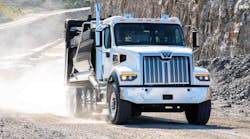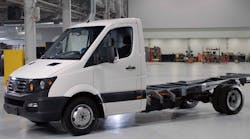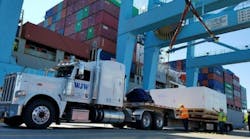Editor’s note: Comments on the glider kit proposal can be filed electronically until Jan. 5.
https://www.regulations.gov/document?D=EPA-HQ-OAR-2014-0827-2368
The Environmental Protection Agency (EPA) has received more than 24,000 comments in response to its proposal to repeal earlier efforts that would effectively phase out glider kits as part of the Phase 2 greenhouse gas regulation.
Most of comments posted online thus far are from individuals, and often focus on the economics behind the decision, rather than strictly the potential environmental impact of glider kits. Among truckers, officials with small fleets tend to favor the glider option, while dealerships have generally opposed them.
The Phase 2 rule, issued in 2016 by EPA and the National Highway Traffic Safety Administration, called for rebuilt engines installed in gliders to satisfy emission standards in the year they were assembled in relation to the engine. It also would have capped how many gliders manufacturers could produce in a year.
EPA has estimated about 10,000 gliders are manufactured annually and make up about 5% of the entire Class 8 truck market. However, gliders could account for about one-third of all nitrogen oxides and particulate matter emissions from the sector, according to the agency.
Citing “the regulatory overreach” of the Obama administration, new EPA administrator Scott Pruitt ruled gliders should not be regulated as “new motor vehicles” or “new motor vehicle engines” under the Clean Air Act, and opened a public comment period that ends Jan. 5.
It is common for a rush of comments to be filed just prior to the deadline, so it is likely the final number received will rise significantly. In late December, the Owner-Operators Independent Drivers Association (OOIDA) urged members to submit comments in support of the repeal.
“We know [American Trucking Associations] and the corporate interests they represent will be opposing the repeal along with various environmental groups, so we will need all the positive comments we can get as the EPA reviews public input and makes their final decision,” OOIDA wrote.
A number of small fleets already filed detailed comments in favor of allowing gliders.
R. Kyle Fresh, president of WJW Associates in Florida, wrote that glider kits allow the fleet “to maintain our own vehicles, have much greater uptime, and attract new talent to our company.” Newer engines with emissions reduction technology “simply do not work well.”
“Not only do we have too much downtime, but maintenance shops are packed with other companies' equipment having similar issues,” he said.
Lane Parker, president of Trinity Transport Inc. of North Carolina, said that without gliders his small fleet would run older trucks longer because of the cost of new equipment.
“Gliders are much more environmentally friendly than continuing to keep older trucks on the road indefinitely, which is what will ultimately happen,” he wrote.
Similarly, Kyle Moye, assistant operations manager of Moving Office Equipment in Georgia, called gliders “a middle ground for small fleets between extremely expensive new trucks and old worn out used ones.” The company, which runs about 40 trucks, previously purchased older used equipment from larger carriers, “but ended up spending more in maintenance and downtime rentals that it became uneconomically sensible.”
John Kennelly from Skunk River Transport said new trucks are “much more expensive but the freight rates have not increased to match the increased cost of new equipment.” He said gliders are less expensive because they do not require a diesel exhaust fluid and require less maintenance.
Jerry Gray, manager of Gray Logging LLC in Florida, also defended the use of gliders, saying they cost less and “get the best fuel mileage of all the trucks in our fleet and have had the fewest breakdowns which has led to less downtime and maintenance cost.”
These comments are in stark contrast to Patrick Quinn, executive director of the Heavy Duty Fuel Efficiency Leadership Group, which includes Cummins, Eaton, FedEx, PepsiCo, Wabash National, and Waste Management.
Quinn said these companies value regulatory certainty, and changing the rules at this stage undermines investment decisions.
“The policy was designed to allow gliders for legitimate purposes, such as salvaging a relatively new powertrain from a vehicle chassis badly damaged in a crash, while ensuring a level playing field for manufacturers of trucks and engines,” he wrote. “We are concerned that the EPA proposal to repeal the glider kit portion of the Phase 2 Rule could lead to an inconsistent patchwork of federal and state requirements, producing uncertainty for truck and engine manufacturers and fleets.”
A number of truck dealers opposed the proposed change, even those selling glider kits.
“While I stand as a partial owner to win financially from rolling the regulations back I find it exceptionally difficult to reconcile with it when I know clearly what the right thing to do,” wrote Justin Hopkins, part of the ownership group for Truck Centers Inc., which sells Freightliner and Western Star trucks in Illinois, Indiana, and Missouri.
With new trucks now often emitting cleaner air than they are taking in, he asked, “why would we as a governing body decide to allow ourselves to create a secondary market for dirty engines on less efficient trucks after we went through everything already?”
Hopkins also took issue with the suggestion that gliders are significantly cheaper, suggesting that updated IRS guidelines states new gliders are subject to the 12% federal excise tax.
Chris Bruckner, dealer principal of Brucker Truck Sales, said allowing gliders puts his 26 Mack and Volvo dealerships at an unfair disadvantage in the marketplace. Additionally, he said that existing gliders avoiding the excise tax are skirting money that is needed for the Highway Trust Fund.
“We miss out on the sales of the very vehicles that would be deployed in the construction and repair of highway infrastructure,” said Brucker, adding that “I simply want a level playing field so that we can fairly compete.”
Truck Country of Wisconsin president Doug McCoy focused his comments on the health implications, writing that “properly regulating the glider kit issue will improve the health care of all citizens as we try to address greenhouse gas emissions for future generations.”
In a recent opinion piece published in Fortune magazine, Margo Oge, director of the EPA’s Office of Transportation and Air Quality from 1994 to 2012, wrote the agency’s current position on gliders is “really no different from allowing manufacturers to sell cars without seatbelts.”









